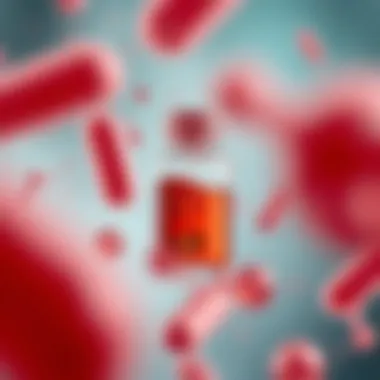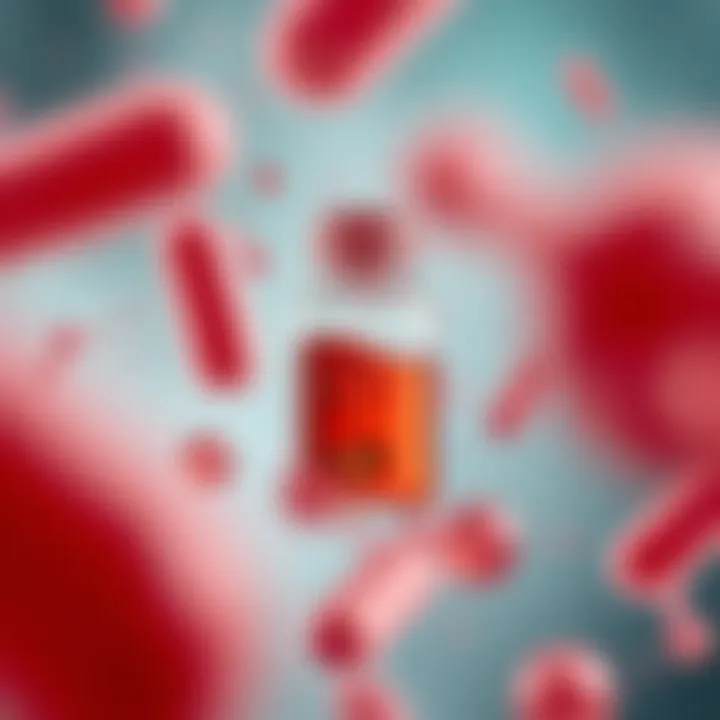The Role of Vitamins in Hemoglobin Regulation


Intro
The relationship between vitamins and hemoglobin levels is intricate and multifaceted. Hemoglobin, the protein within red blood cells, plays a pivotal role in transporting oxygen throughout the body. Understanding how specific vitamins affect hemoglobin levels is crucial for avoiding conditions such as anemia, which can have serious health repercussions. With this in mind, this article aims to shed light on vitamins B12, B9 (folate), and C, exploring both their dietary sources and the mechanisms through which they influence hemoglobin production.
Deficiencies in these vitamins can lead to a cascade of health issues, all stemming from poor oxygen transport in the body. It becomes critical, therefore, to ensure that one's diet is rich in essential nutrients to maintain optimal hemoglobin levels.
Importance of the Research
Anemia is a condition that often goes unrecognized until it is significantly advanced. Understanding the biochemical relationship between vitamins and hemoglobin not only empowers individuals to make informed dietary choices but also encourages health professionals to address nutritional deficiencies more proactively. Through this exploration, readers will gain insight into how improving their vitamin intake can enhance their overall well-being.
Results and Discussion
Presentation of Findings
Research illustrates that vitamin B12 is essential for the proper formation of red blood cells. Without adequate B12, red blood cell production may slow, leading to a type of anemia known as pernicious anemia. Folate, or vitamin B9, underpins the synthesis of DNA in red blood cells, and its deficiency can similarly halt their production. Meanwhile, vitamin C plays a supportive role by enhancing iron absorption, a mineral that collaborates with hemoglobin to facilitate oxygen distribution.
"To maintain our hemoglobin levels, we must consider vitamins as essential players, not just background noise in our dietary intake."
Implications of Results
The implications of these findings are wide-ranging. For individuals, recognizing that a balanced intake of B12, B9, and vitamin C is crucial could lead to changes in dietary habits that promote better health outcomes. For clinicians and health educators, this underscores the importance of screening for vitamin deficiencies when evaluating patients with symptoms suggestive of anemia, such as fatigue and pallor.
Further Reading
- National Institutes of Health - Office of Dietary Supplements
- World Health Organization - Anemia
- Mayo Clinic - Vitamin B12 Deficiency
Understanding Hemoglobin
Understanding hemoglobin is crucial when delving into the relationship between vitamins and hemoglobin levels. Hemoglobin serves as a linchpin in the human body, playing a pivotal role in various physiological processes. Its primary function is to transport oxygen from the lungs to the body's tissues while carrying carbon dioxide back to the lungs for exhalation. This dual capability establishes hemoglobin as essential for sustaining life.
Definition and Function
Hemoglobin is a complex protein found in red blood cells, composed of four subunits, each containing an iron atom bound to a heme group. This structure allows hemoglobin to effectively bind to oxygen in the lungs and release it in tissues where it’s needed. The presence of iron is not merely incidental; it’s fundamental to hemoglobin’s ability to carry oxygen. When we think about oxygen transport, we must recognize that hemoglobin’s efficiency relies heavily on the availability of iron, as well as the vitamins that aid in its absorption and utilization.
The Importance of Hemoglobin
Hemoglobin is more than just a vessel for oxygen and carbon dioxide; it plays a critical role in maintaining the body’s overall health. When hemoglobin levels are adequate, it ensures that muscles and organs receive the oxygen they require for optimal functioning.
Oxygen Transport
The oxygen transport aspect of hemoglobin cannot be understated. When red blood cells carry oxygen to various cells, it allows those cells to convert it into energy through cellular respiration. This process is crucial; without sufficient oxygen, cells can’t produce energy efficiently, leading to fatigue and a slew of other health issues. A significant characteristic of oxygen transport is its rapid reversibility. Hemoglobin can pick up oxygen in the lungs and release it where it's needed swiftly, making it particularly effective.
"The body’s ability to generate energy hinges on the efficiency of hemoglobin in transporting oxygen."
One unique feature of oxygen transport is its systemic nature; it affects not just one organ but the entire physiology of the body. The advantage here is clear: a well-functioning hemoglobin system supports overall health, enhancing physical performance, cognitive function, and even mood stability. In a broader scope, understanding oxygen transport through hemoglobin gives insights into conditions like chronic fatigue and anemia.
Carbon Dioxide Elimination
Following oxygen delivery, hemoglobin also plays a vital role in carbon dioxide elimination. As cells produce energy, they generate carbon dioxide as a byproduct, which must be expelled from the body. Hemoglobin facilitates this by binding carbon dioxide and transporting it back to the lungs for exhalation. This function is equally important for maintaining the body’s acid-base balance, which is vital for overall homeostasis.
A distinguishing characteristic of carbon dioxide elimination through hemoglobin is how it works in a cooperative manner. The binding of carbon dioxide alters hemoglobin’s shape, enabling it to release oxygen more efficiently in tissues. This process enhances oxygen delivery precisely where it’s needed, a beautiful illustration of the body's innate ability to self-regulate.
The elimination of carbon dioxide also presents advantages—maintaining a proper balance can prevent respiratory acidosis and ensure our body functions within an optimal pH range. For those studying or working within health sciences, recognizing the synergy between hemoglobin's dual functions of oxygen transport and carbon dioxide elimination can unlock further understanding of various metabolic disorders.
Vitamin B12 and Hemoglobin
Vitamin B12, also known as cobalamin, is a critical player in processes that involve hemoglobin and overall health. This vitamin directly influences the production of red blood cells, ensuring that they form adequately and function properly. A sufficient supply of Vitamin B12 is essential for maintaining optimal hemoglobin levels, thus preventing conditions like anemia and improving oxygen delivery throughout the body. The body's reliance on Vitamin B12 highlights its role as a powerhouse nutrient—without it, our blood and overall energy levels may dwindle.
Role in Red Blood Cell Formation
Vitamin B12 is pivotal in the process of red blood cell formation, primarily due to its substantial involvement in DNA synthesis. When the body does not get enough of it, the production of these cells can falter, leading to fewer red blood cells being created. This deficiency can ultimately cause a condition known as megaloblastic anemia, characterized by the production of unusually large red blood cells that cannot transport oxygen effectively.
Furthermore, Vitamin B12 works hand-in-hand with folate (Vitamin B9) in the synthesis of DNA, which is critical for the maturation of red blood cells. Their combined effect highlights the importance of a balanced diet containing both nutrients to ensure the body performs at its best.


Sources of Vitamin B12
Animal Products
Animal products are one of the most reliable sources of Vitamin B12. Foods like beef, liver, clams, and fish show high levels of this essential nutrient. The key characteristic of these animal-derived foods is their high bioavailability, meaning the body can easily digest and absorb the Vitamin B12 they contain. This makes them a beneficial choice for those looking to boost their hemoglobin levels and overall health. While they do have higher fat content that may concern some consumers, the rich nutrient profile often outweighs these concerns for most people.
Unique Feature: The absorption of Vitamin B12 from animal sources is generally more effective than from plant sources, providing a significant advantage in dietary choices.
Fortified Foods
For those who follow a vegetarian or vegan lifestyle, fortified foods can be a great alternative for obtaining Vitamin B12. These foods, such as cereals, plant-based milks, and nutritional yeast, are often enriched with added vitamins, making them a popular choice among those who do not consume animal products. The key here is that these fortified products help bridge the gap in the diets of individuals who might be at risk of deficiency.
Unique Feature: Fortified foods provide a flexible option for obtaining essential nutrients, allowing broader access to Vitamin B12 for those adhering to various dietary preferences. However, the absorption rate can vary, and one must check labels to ensure they contain adequate amounts of the vitamin required for the body.
Deficiency and Its Effects
A lack of Vitamin B12 in the body can lead to a range of detrimental health issues. As mentioned earlier, megaloblastic anemia is a critical consequence, where the body struggles to create red blood cells efficiently. Without enough healthy red blood cells, fatigue, weakness, and other symptoms can arise, potentially impacting daily activities.
Additionally, prolonged deficiency can lead to neurological issues, as Vitamin B12 plays a role in maintaining nerve health. Symptoms can include numbness, tingling, and even mood changes. This highlights not only the importance of monitoring Vitamin B12 intake but also emphasizes the interconnectedness of vitamins, minerals, and bodily functions.
Ensuring sufficient Vitamin B12 levels through dietary sources, supplements, or fortified foods is a crucial step towards maintaining optimal hemoglobin levels and overall health.
Folic Acid (Vitamin B9) and Hemoglobin
Folic acid, also known as vitamin B9, plays a crucial role when it comes to the production of hemoglobin. It contributes significantly to the synthesis of DNA and the formation of red blood cells. Given that hemoglobin is essential for carrying oxygen throughout the body, understanding folic acid’s function is vital for health, especially in the context of anemia where hemoglobin levels are often compromised. Bone marrow, where red blood cells are produced, relies heavily on folic acid for its operations, making this vitamin a key player in blood health.
Impact on DNA Synthesis
Folic acid is intricately linked to DNA synthesis. During cell division, particularly in rapidly dividing cells like those in bone marrow, adequate folate levels are needed to ensure that DNA is correctly copied. This replication is fundamental to producing healthy red blood cells. When there’s a shortage of folic acid, DNA synthesis becomes impaired, which leads to alterations in cell production. As a result, the bone marrow produces larger-than-normal red blood cells that are often less efficient in their oxygen transport capabilities. In many cases, this can culminate in megaloblastic anemia, which showcases the importance of folic acid in maintaining optimal hemoglobin levels.
Dietary Sources of Folate
Dietary intake of folate is critical to prevent deficiencies that could hinder red blood cell formation and hemoglobin levels. Here are some notable sources:
Leafy Greens
Leafy greens are among the top food sources rich in folate. Spinach, kale, and collard greens not only offer a green appeal but are packed with essential nutrients, including folic acid. These greens are celebrated for their ability to provide a vast amount of folate in a low-calorie package, making them a popular choice among health-conscious eaters. The high chlorophyll content in these plants can be particularly advantageous, as it's associated with enhanced blood health and nutrient absorption. However, the drawback may include the risk of oxalate content in certain greens, which can interfere with calcium absorption in some individuals.
Legumes
Legumes like lentils, chickpeas, and beans are exceptional folate sources and contribute significantly to the overall dietary intake of this essential vitamin. Legumes are not only inexpensive and versatile but they also bring high levels of protein and fiber to the table. This makes them a beneficial choice for those looking to improve their hemoglobin levels while enjoying a hearty meal. They’re particularly viable for vegetarian and vegan diets. Yet, the downside can come from their gassy nature, which might not sit well with everyone’s digestive system.
Consequences of Folate Deficiency
Deficiency in folate has notable consequences, particularly for hemoglobin production. As previously mentioned, insufficient folic acid can lead to megaloblastic anemia, where the red blood cells become abnormally large and dysfunctional. This condition can lead to fatigue, weakness, and an increased risk of infections due to diminished red blood cell efficiency in transporting oxygen. Additionally, long-term deficiency can contribute to birth defects during pregnancy, underscoring the importance of adequate folate levels in women of childbearing age. Early detection and dietary adjustments are crucial to mitigate these risks and optimize hemoglobin levels.
Vitamin 's Functionality in Hemoglobin Production
Vitamin C, often taken for granted, plays a pivotal role in the production of hemoglobin, the protein in our blood responsible for oxygen transport. Its influence on overall iron metabolism can’t be overstated. In essence, Vitamin C is not just a supporting player; it acts as a catalyst for necessary processes that keep hemoglobin levels in check. By enhancing iron absorption in the gut, Vitamin C directly aids in red blood cell development and improves overall blood health. The interplay between Vitamin C and iron is crucial to understanding how our body maintains optimal hemoglobin levels.
Enhancing Iron Absorption
When it comes to iron absorption, Vitamin C is like a trusty sidekick in a superhero movie. Its presence can significantly improve the body’s ability to take in iron from dietary sources. Without enough Vitamin C, your body might struggle to utilize the iron found in meals, especially from plant-based sources, known as non-heme iron.
- Iron Availability: Heme iron, found in animal products, is already easier to absorb, but non-heme iron requires a little boost from Vitamin C. When consumed together, for instance, a salad drizzled with lemon juice, the enhancement happens. This vitamin reduces ferric iron to its ferrous state, making it more bioavailable.
- Impact of Cooking: It’s worth mentioning that cooking can reduce Vitamin C content in foods, so enjoying raw fruits and veggies can ensure you get the full advantage.
This synergistic relationship between Vitamin C and iron isn’t just something to consider during meal prep; it’s foundational for preventing anemia, which is closely related to low hemoglobin levels.
Natural Sources of Vitamin
A diet rich in Vitamin C can be incredibly effective in promoting hemoglobin levels. Below are some nutrient-dense sources:
Citrus Fruits
Citrus fruits like oranges and grapefruits are among the most well-known sources of Vitamin C. Their high acidity not only makes them a delicious snack but also enhances iron absorption from meals when eaten together.


- Key Characteristic: They are widely recognized for their refreshing taste and juicy texture.
- Health Benefits: Not only do they provide Vitamin C, but they also offer antioxidants that contribute to overall cell health. However, their acidity can be harsh on some people's stomachs, so moderation might be key for those sensitive.
- Unique Feature: The bioavailability of Vitamin C in fresh citrus is high, meaning that your body can readily make use of the vitamin right away.
Peppers
All varieties of peppers, especially bell peppers, pack a Vitamin C punch much greater than that of citrus fruits. They bring water, fiber, and countless phytonutrients to the table, which are essential in overall health.
- Key Characteristic: Their vibrant colors and crisp textures make them a versatile and appealing addition to many dishes.
- Health Benefits: Phytochemicals found in peppers work synergistically with Vitamin C to support the immune system, thus indirectly aiding red blood cell production and, in turn, hemoglobin levels.
- Unique Feature: Unlike citrus fruits, peppers can be enjoyed cooked or raw, offering diverse culinary options while still delivering high levels of Vitamin C.
Importance of Vitamin in Diet
Incorporating Vitamin C into your daily diet isn't just for preventing a stuffy nose. It's integral for maintaining robust hemoglobin levels and ensuring that your body can efficiently use the iron it consumes. Regularly eating a mix of fruits and vegetables high in this vitamin elevates both overall health and iron metabolism, leading to improved vigor and vitality.
"It’s not just about the quantity of iron in your diet; it’s about making sure your body can use it."
Overall, Vitamin C contributes not just to the prevention of anemia but opens the pathway to better health by ensuring that your hemoglobin levels remain healthy and effective.
Iron: The Backbone of Hemoglobin
Iron is undeniably the backbone of hemoglobin, playing a critical role in ensuring that our bodies receive the oxygen they need to function optimally. Hemoglobin requires iron to carry oxygen from the lungs to the tissues and organs, allowing for effective metabolic processes. Without sufficient iron, hemoglobin synthesis is compromised, leading to decreased oxygen transportation and various health issues, most notably anemia.
It’s important to understand the different types of iron that are available to us through our diet, as not all forms are created equal. The nuances between these types can significantly affect our overall iron absorption and health.
Types of Iron: Heme vs. Non-Heme
When it comes to dietary iron, two primary forms exist: heme iron and non-heme iron. Heme iron is found exclusively in animal products, such as red meat, poultry, and fish. It boasts superior absorption rates, often estimated at 15-35%. On the other hand, non-heme iron comes from plant sources like beans, lentils, and leafy greens, as well as fortified foods. Its absorption rate is significantly lower, ranging from 2-20%, making dietary considerations vital for those relying on plant-based sources.
The body regulates the absorption of non-heme iron based on its needs, which means factors such as existing iron levels and overall health significantly come into play. So, while non-heme iron is indeed a valuable source, combining it with vitamin C-rich foods can boost its absorption and thus improve overall iron intake.
Iron-Rich Foods
Meat and Poultry
Meat and poultry are considered top-tier sources of iron, particularly heme iron. A steak or roasted chicken breast can quickly uplift your iron levels due to the essential nutrients they provide. Not only does meat deliver high bioavailability of iron, but these foods also come packed with proteins and essential minerals. The consumption of red meat, especially from grass-fed sources, is often emphasized for those particularly struggling with anemia or low hemoglobin levels.
Caution is warranted, however; excessive intake of red meat can impose other health risks, such as an increased chance of cardiovascular disease.
Plant-Based Sources
Plant-based sources of iron, like legumes, tofu, and quinoa, also hold a significant spot in the dietary landscape. Though they contain non-heme iron, these foods bring a wealth of other nutrients, such as fiber, vitamins, and phytonutrients. Adding a variety of vibrant fruits and vegetables can help mitigate the lower absorption rates of non-heme iron, enhancing your diet holistically. Legumes like lentils absorb well, especially when paired with nutrient enhancers like bell peppers.
However, it should be noted that substances like oxalates found in certain plants can hinder iron absorption, so it's wise to vary choices and methods of preparation to maximize iron intake.
Iron Deficiency Anemia
Iron deficiency anemia occurs when the body lacks sufficient iron to produce hemoglobin for red blood cells. Symptoms can range from common fatigue and weakness to more severe effects such as heart problems. The condition may arise from various factors, including inadequate dietary intake, chronic blood loss, or increased demands due to growth periods or pregnancy.
Regular check-ups and blood tests can help monitor hemoglobin and iron levels, making it possible to tackle any deficiencies accurately and promptly. The key takeaway is that incorporating a balanced intake of both heme and non-heme iron into your meals can contribute significantly to maintaining optimal hemoglobin levels, thus supporting overall health.
Regular monitoring, diverse dietary sources, and a balanced approach can pave the way for better iron status, something essential for anyone managing hemoglobin health.
Incorporating iron-rich foods into daily meals can strengthen your intake substantially, ensuring your hemoglobin remains at healthy levels and supporting your body’s oxygen transport capabilities.
Overall Dietary Considerations
When it comes to maintaining healthy hemoglobin levels, diet plays a crucial role. A balanced diet isn't just about keeping the scale in check; it directly affects various aspects of our health, with hemoglobin being a prime example. The nutrients we consume support red blood cell production and oxygen transport, which are essential for overall bodily function. This section will explore the key elements necessary for supporting hemoglobin health, focusing specifically on dietary variety, the importance of specific nutrients, and the role of supplementation when needed.
Balanced Diet for Hemoglobin Health
A balanced diet is like a symphony; every nutrient must play its part to create harmony within the body. Essential vitamins and minerals—such as Vitamin B12, folate, and iron—are paramount in this mix. Each food group contributes uniquely to hemoglobin levels, highlighting the necessity of incorporating diverse foods into one's meals. For instance, while red meat is often hailed for its iron content, leafy greens like spinach and kale are also rich sources of iron, albeit in a non-heme form, which is less readily absorbed but still beneficial.
Including foods rich in Vitamin C, such as citrus fruits and bell peppers, can further enhance iron absorption, showing how certain vitamins work in concert with one another. A well-rounded diet can look something like this:
- Protein Sources: Lean meats, poultry, seafood, legumes
- Vegetables: Broccoli, spinach, carrots
- Fruits: Oranges, strawberries, kiwi
- Grains: Quinoa, brown rice, whole wheat bread
By incorporating these varied food sources, individuals can effectively support their hemoglobin production and overall health.
Supplements: When and Why
Not everyone can obtain all their nutrients solely through food, especially those with dietary restrictions or specific health conditions that hinder nutrient absorption. This is where supplements step in. They can serve as an effective back-up plan for those who might not meet their nutritional needs through diet alone. For instance, vegetarians may struggle to get sufficient amounts of Vitamin B12 since it is predominantly found in animal products. A supplement can help bridge this gap.


However, supplementation should not be a knee-jerk reaction. It's essential to assess one's diet first. Consulting a healthcare provider can clarify whether deficiencies are present and what specific supplements may be beneficial. The timing of supplementation can also impact its effectiveness—potentially taking iron supplements with a vitamin C source might enhance absorption. It’s carefully determining what, when, and why you should take these nutrients that leads to the best health outcomes.
Potential Risks of Over-Supplementation
While supplements can be beneficial, there's a fine line between achieving adequate nutrition and going overboard. Over-supplementation poses several risks, particularly with fat-soluble vitamins that can accumulate in the body, leading to toxicity. For example, excessive Vitamin A can cause liver damage, while too much iron can result in organ damage and other severe health complications.
It's vital to approach supplementation with caution. Monitoring doses and prioritizing a nutrient-rich diet can mitigate these risks. Here are some critical considerations:
- Regular Testing: Periodic blood tests can reveal nutrient levels, helping guide supplementation decisions.
- Consulting a Pro: Speak with a healthcare provider about any concerns regarding nutrient intake, whether through diet or supplements.
- Educated Choices: Choosing high-quality supplements from reputable brands can also lead to better health outcomes.
"A little knowledge can be a dangerous thing. Better safe than sorry!"
In sum, understanding the dietary landscape and the role of supplements can empower individuals to take control of their hemoglobin health. The interplay of various vitamins and minerals ensures the body remains in balance, so one must tread carefully and consider all dietary aspects to avoid unnecessary risks. Regular check-ups and staying informed about one's nutritional intake are key to a robust body.
Monitoring Hemoglobin Levels
Monitoring hemoglobin levels is critical for understanding and maintaining overall health. Hemoglobin, the protein in red blood cells responsible for transporting oxygen, serves as an important indicator of various physiological states. Regular assessment of hemoglobin levels can help catch deficiencies early on and guide dietary or medical interventions as needed. This section will address key aspects of monitoring, its significance, and what the results indicate.
Importance of Regular Check-ups
One might think that hemoglobin levels are only something to worry about in extreme cases, but regular check-ups can be the difference between being proactive in health and reactive. When we schedule routine blood tests, we gain valuable insights into our body's oxygen-carrying capacity. Low hemoglobin can suggest anemia, which can stem from a variety of causes, such as vitamin deficiencies or chronic diseases.
- Early Detection: Regular tests can uncover issues before they escalate. For instance, mild anemia may not have overt symptoms, but it can lead to fatigue and weakness if left unchecked.
- Informed Decisions: Knowing hemoglobin levels can facilitate informed discussions with healthcare providers regarding diet, supplementation, or further testing. For instance, if levels are found to be low, immediate focus might be directed towards increasing iron or vitamin intake.
- Underlying Conditions: Frequent monitoring can reveal potential underlying health issues. Fluctuations in hemoglobin can suggest conditions such as kidney disease or bone marrow disorders, prompting further evaluation.
Indicators of Healthy Hemoglobin Levels
Understanding what constitutes a healthy hemoglobin level is crucial. While specific measurements can vary based on a person's age and sex, generally:
- For adult men, normal levels are typically between 13.8 to 17.2 grams per deciliter (g/dL).
- For adult women, the range usually lies between 12.1 to 15.1 g/dL.
A few indicators of healthy hemoglobin levels include:
- Energy Levels: A well-functioning hemoglobin level often correlates with good energy levels. If you feel easily fatigued, it could be a sign of low hemoglobin.
- Skin and Nail Health: Pale skin or brittle nails can sometimes signal issues with hemoglobin. While not exclusive to low levels, these signs warrant further testing.
- Heart Rate and Breathing: Higher than normal heart rates or shortness of breath during basic activities may indicate inadequate hemoglobin levels, as the body struggles to deliver sufficient oxygen.
Diagnostic Tests and What They Reveal
Diagnostic tests, particularly a complete blood count (CBC), are fundamental in assessing hemoglobin levels.
- CBC Test: During a CBC, a healthcare professional will draw blood to determine hemoglobin concentration, among other factors. This test is routine and provides a wealth of information.
- Possible Outcomes: Depending on the results:
- High hemoglobin levels may suggest dehydration or lung disease among other conditions.
- Low values could reflect anemia, which has various causes ranging from dietary deficiencies to more serious health issues.
Monitoring hemoglobin levels is not merely about identifying abnormalities; it is about fostering a proactive approach to nutrition and health management.
Closure
In summarizing the intricate connections between vitamins and hemoglobin levels, one must grasp the overarching significance of incorporating these nutrients into one’s diet. Vitamins B12, B9, and C play pivotal roles that extend beyond mere theoretical knowledge; they directly influence the body’s capacity to produce healthy red blood cells. This process is crucial as hemoglobin is the molecule responsible for oxygen transport, and deficiencies can lead not just to tiredness, but to serious health issues such as anemia.
Summarizing Vitamin Roles
When considering the roles of vitamins in hemoglobin health, it's pivotal to highlight that:
- Vitamin B12 is essential for the production and maturation of red blood cells. Without it, the body struggles to produce sufficient healthy cells, leading to elevated levels of homocysteine, which can complicate cardiovascular health.
- Vitamin B9 (Folate) contributes significantly to DNA synthesis and is a key player in cell division. Low levels can hinder the body’s ability to form new cells, perpetuating anemia and other health troubles.
- Vitamin C, often celebrated for its immune-boosting properties, also aids in enhancing iron absorption. This nutrient can't single-handedly increase hemoglobin levels, but when coupled with sufficient iron intake, it can greatly facilitate the overall process of hemoglobin distribution throughout the body.
The synergy between these vitamins culminates in effective red blood cell formation and function.
Future Directions in Research
As we journey into the future of nutritional science, there are vast horizons to explore regarding vitamins’ influence on hemoglobin levels. Current research is shifting toward:
- Holistic dietary patterns that include vitamins and their interactions with each other, rather than isolating specific nutrients for study. Understanding how food combinations affect nutrient absorption could lead to better dietary recommendations.
- Genetic factors influencing individual responses to vitamin supplementation and their consequent effects on hemoglobin levels. Some people may respond differently to B12 or C intake based on their genetic make-up.
- Longitudinal studies observing the effects of long-term vitamin supplementation on various populations may provide deeper insights into preventative measures for anemia.
This ongoing research will sharpen our understanding and enable more personalized approaches to nutrition.
Practical Implementation of Findings
Translating research findings into practical advice is essential for improving public health. Here are some steps that individuals can take:
- Maintain Dietary Variety: Incorporating a wide range of foods rich in vitamins B12, B9, and C. This includes meats, dairy, legumes, leafy greens, and citrus fruits. A colorful plate can be quite a nutrient powerhouse.
- Consider Routine Check-ups: Regular blood tests can help monitor hemoglobin levels as well as check vitamin deficiencies before they develop into more serious conditions.
- Supplement Wisely: If dietary intake is insufficient and after consulting with healthcare professionals, consider supplementation to fill gaps in nutrition. Over-supplementation is risky and should be avoided unless specifically advised.
By adopting these practical strategies, individuals can take proactive steps towards improving their hemoglobin levels and overall health.















